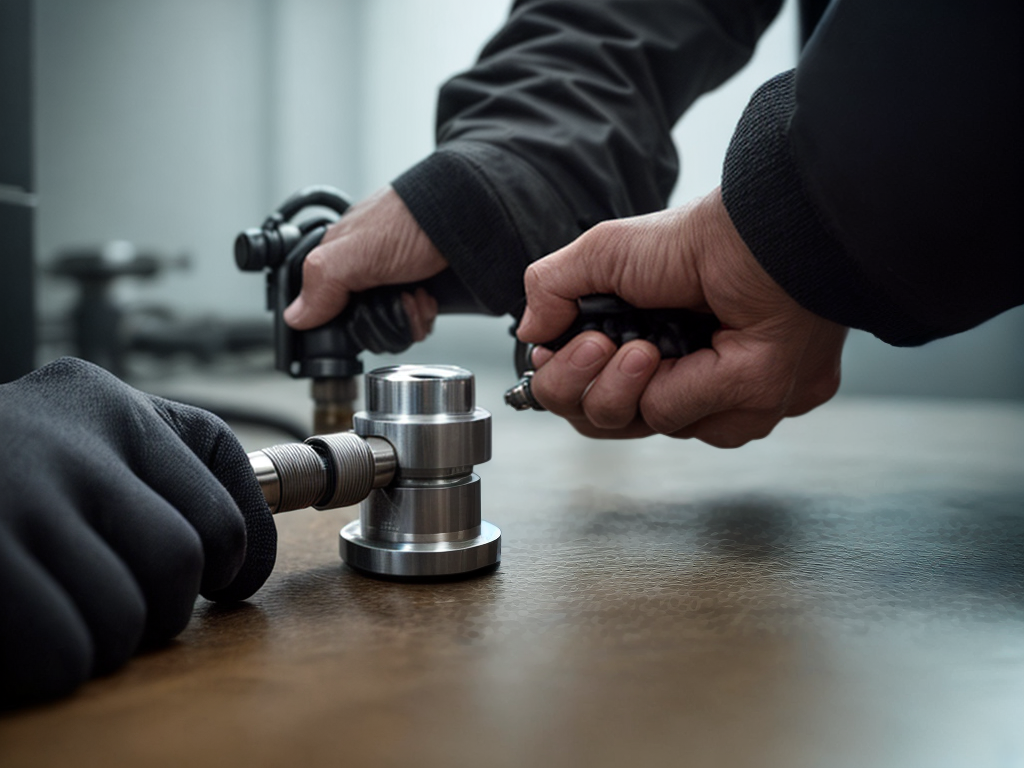
As I stand in front of a complex network of pipes and valves, it’s hard to ignore the delicate balance between functionality and maintenance. Valves, though often overlooked, are the unsung heroes of any system, ensuring the smooth flow of liquids or gases. In this video tutorial, I will guide you through the step-by-step process of installing and maintaining your valves, equipping you with the knowledge and techniques to keep your systems running efficiently. So, if you’ve ever wondered how to tackle valve installation or how to troubleshoot common issues, stay tuned for a comprehensive exploration of this crucial component.
Tools and Materials Needed
To install and maintain valves, you will need a specific set of tools and materials. Having the right valve installation tools is crucial to ensure a successful and efficient installation process. Here are some essential tools you should have:
-
Pipe Wrench: A pipe wrench is a versatile tool used to tighten or loosen threaded pipes and fittings. It provides a firm grip and allows for easy manipulation of pipes during installation.
-
Adjustable Wrench: An adjustable wrench is useful for tightening or loosening nuts and bolts. It can be adjusted to fit different sizes, making it a handy tool for valve installation.
-
Pipe Cutter: A pipe cutter is essential for cutting pipes to the correct length. It ensures clean and precise cuts, enabling a proper fit for the valves.
-
Deburring Tool: After cutting the pipes, a deburring tool is used to remove any rough edges or burrs. This ensures a smooth surface, preventing any interference with the valve’s functionality.
When selecting materials for valve installation, there are a few tips to keep in mind:
-
Material Compatibility: Ensure that the valves and pipes are made from compatible materials. This prevents corrosion and extends the lifespan of the installation.
-
Pressure and Temperature Ratings: Consider the pressure and temperature conditions in which the valves will operate. Choose materials that can withstand these conditions to avoid failures or leaks.
-
Durability: Opt for high-quality materials that are durable and resistant to wear and tear. This ensures a longer lifespan and reduces the need for frequent replacements or repairs.
Step 1: Preparing for Valve Installation
Before beginning the valve installation process, there are several important points to consider. First, ensure that you have all the necessary equipment and tools readily available. This includes items such as wrenches, pipe cutters, and thread sealant. Next, carefully select the appropriate valve for your specific application, taking into account factors such as material compatibility and flow requirements. Lastly, always prioritize safety by wearing protective gear and following proper procedures to prevent accidents or injuries during the installation process.
Equipment and Tools
Using the appropriate equipment and tools is essential for the successful installation and maintenance of valves. When it comes to valve maintenance techniques, having the right tools can make all the difference. One of the most important tools for valve maintenance is a valve wrench. This tool allows you to easily tighten or loosen the valve without causing any damage. Additionally, a pressure gauge is crucial for monitoring the pressure in the valve system. By regularly checking the pressure, you can identify any potential issues before they become major problems. Another helpful tool is a valve cleaning brush, which can be used to remove any debris or buildup that may be affecting the valve’s performance. Lastly, having a valve troubleshooting guide on hand can provide valuable information and solutions for common valve issues. Remember, using the proper equipment and tools will ensure that your valves are installed and maintained correctly, resulting in optimal performance and longevity.
Valve Selection
Having the appropriate equipment and tools is crucial for successful valve installation and maintenance, and the first step in preparing for valve installation is selecting the right valve for the job. Valve selection is a critical process that requires careful consideration of various factors. When choosing a valve, it is important to assess the specific requirements of the application and consider factors such as flow rate, pressure, temperature, and media compatibility. Other criteria to consider include the valve type, size, material, and end connections. Different valve installation techniques may also need to be considered based on the specific application. By carefully evaluating these valve selection criteria and considering the unique needs of the installation, you can ensure that the chosen valve will perform optimally and reliably in your system.
Safety Precautions
To ensure the safety of the valve installation process, it is crucial to adhere to proper safety precautions. By following these guidelines, you can minimize the risk of accidents and maintain a safe working environment. Here are some key safety precautions to consider during the valve installation process:
| Safety Precaution | Description |
|---|---|
| Conduct a Risk Assessment | Before starting any valve installation, assess potential hazards and develop a plan to mitigate them. Identify any potential risks and take appropriate measures to avoid accidents. |
| Wear Protective Gear | Always wear the necessary protective gear, such as gloves, safety glasses, and steel-toed boots, to protect yourself from any potential injuries or hazards during the installation process. |
| Follow Lockout/Tagout Procedures | Implement lockout/tagout procedures to ensure the valve is properly isolated and no unexpected energization occurs during installation or maintenance. |
| Use Proper Lifting Techniques | When handling heavy valves, use proper lifting techniques to prevent strains or back injuries. Lift with your legs, not your back, and ask for assistance if needed. |
Step 2: Removing Old Valves (If Applicable)
Now that we are ready to remove old valves, it is important to follow a proper valve removal process. This includes using the necessary tools for removal, such as pipe wrenches or valve wrenches, and ensuring safety precautions are taken throughout the process. By understanding the steps involved in removing old valves, we can ensure a smooth and efficient valve installation process.
Valve Removal Process
I will remove the old valves, if applicable, using the necessary tools and techniques. The valve removal process is an important step in valve replacement or repair. Before removing the old valve, it is crucial to turn off the water supply and relieve any pressure in the system. Once that is done, the following steps can be followed:
| Tools Needed | Techniques |
|---|---|
| Adjustable wrench | Loosen the valve nuts |
| Pipe cutter | Cut the pipe, if necessary |
| Pipe wrench | Remove the valve from the pipe |
Using an adjustable wrench, loosen the valve nuts to disconnect the valve from the pipe. In some cases, it may be necessary to cut the pipe using a pipe cutter. Finally, use a pipe wrench to completely remove the old valve from the pipe. Dispose of the old valve properly and proceed with the installation of the new valve.
Tools Needed for Removal
Using the appropriate tools is essential for the successful removal of old valves, if applicable, during the valve replacement or repair process. To ensure a smooth and efficient valve removal, you will need the following valve maintenance equipment:
- Adjustable wrench: This versatile tool allows you to loosen and tighten various sizes of nuts and bolts, making it essential for valve removal.
- Pipe wrench: Designed for gripping and turning pipes, a pipe wrench provides the necessary leverage to remove stubborn valves.
- Valve wrench: Specifically designed for valve removal, this tool provides a secure grip and allows for easy turning and loosening of the valve.
- Pliers: Pliers come in handy for gripping smaller components, such as valve stems or packing nuts, during the removal process.
- Screwdriver: A screwdriver is essential for removing screws or other fasteners that may be securing the valve in place.
Safety Precautions During Removal
To ensure the safe and efficient removal of old valves, it is crucial to follow proper safety precautions. First and foremost, always wear the appropriate safety gear, such as gloves and safety glasses, to protect yourself from potential hazards. Before starting the removal process, make sure to isolate the valve from the system to prevent any accidental release of pressure or fluid. When handling the valves, use proper techniques to avoid strain or injury. If the valves are heavy or awkwardly shaped, consider using lifting equipment or asking for assistance to minimize the risk of accidents. Take extra care when disconnecting any piping or connections, ensuring that the area is clear and secure before proceeding. By adhering to these safety guidelines, you can safely remove old valves without compromising your well-being.
Step 3: Installing New Valves
To properly install new valves, carefully follow the manufacturer’s instructions and ensure that all necessary tools are readily available. Here are some key steps to consider during the valve installation process:
-
Step 1: Prepare the work area: Clear the area around the valve and make sure it is clean and free from any debris. This will help prevent contamination and ensure a smooth installation.
-
Step 2: Gather the necessary tools: Before beginning the installation, gather all the tools and equipment needed for the job. This may include wrenches, pipe cutters, and thread seal tape.
-
Step 3: Shut off the water supply: Locate the main water shut-off valve and turn it off to prevent any water flow during the installation process. This will help avoid any potential leaks or accidents.
-
Step 4: Remove the old valve: Carefully remove the old valve by loosening the nuts or bolts that secure it in place. Use caution to avoid damaging any surrounding pipes or fittings.
-
Step 5: Install the new valve: Follow the manufacturer’s instructions to properly install the new valve. Ensure that it is securely attached and properly aligned with the existing plumbing system.
Remember to always refer to the manufacturer’s instructions for specific valve installation techniques. By following these steps and using the appropriate tools, you can successfully install new valves and ensure the proper functioning of your plumbing system.
Step 4: Testing and Adjusting Valve Functionality
After successfully installing the new valve, the next step is to test and adjust its functionality to ensure proper operation. Proper valve performance is crucial for the efficient and reliable functioning of any system. In this step, we will discuss troubleshooting techniques to identify and resolve any issues that may arise during the testing process.
To evaluate the valve’s performance, follow these steps:
-
Visual Inspection: Visually inspect the valve for any external leaks or damage. Ensure that all connections are tight and secure.
-
Pressure Testing: Use a pressure gauge to check the valve’s ability to withstand different pressure levels. Gradually increase the pressure and observe for any leaks or abnormal behavior. Refer to the manufacturer’s specifications for the recommended pressure range.
-
Flow Testing: Measure the flow rate through the valve using a flow meter. Compare the obtained flow rate with the expected flow rate specified by the system requirements. If there is a significant difference, further investigation may be necessary.
Table: Troubleshooting Techniques
| Issue | Possible Cause | Solution |
|---|---|---|
| Leaking valve | Loose connections | Tighten connections or replace gaskets |
| Abnormal behavior | Faulty actuator | Inspect and repair or replace actuator |
| Insufficient flow rate | Partially closed valve | Fully open the valve or adjust settings |
| Obstructed flow path | Clear any obstructions in the pipeline | |
| Inadequate supply pressure | Increase the supply pressure if possible |
Step 5: Valve Maintenance Tips and Techniques
Valve maintenance is a critical aspect of ensuring the long-term functionality and reliability of the system. Proper maintenance techniques help prevent valve failures, optimize performance, and extend the lifespan of the valves. Here are some essential valve maintenance tips and techniques:
- Regular Inspection: Conduct routine inspections to identify any signs of wear, corrosion, or leaks. Inspect the valve body, seals, stems, and connections for any abnormalities.
- Lubrication: Apply appropriate lubricants to ensure smooth operation and reduce friction between moving parts. Lubrication helps prevent valve sticking and enhances overall performance.
- Cleaning: Keep valves clean from debris, sediment, or any other foreign matter that may hinder their operation. Use appropriate cleaning agents and techniques for different valve types.
- Valve Exercising: Regularly operate valves through their full range of motion to prevent them from becoming stuck or seizing. This technique helps maintain proper sealing and functionality.
- Maintenance Schedule: Develop a valve maintenance schedule based on manufacturer recommendations and industry best practices. Regularly perform preventive maintenance tasks such as lubrication, cleaning, and inspection.
Troubleshooting Common Valve Issues
One frequent challenge when working with valves involves troubleshooting common issues that may arise during their operation. It is important to identify and address these issues promptly to ensure the optimal performance of your valves. Two common valve issues that require troubleshooting are valve leaks and malfunctions. In this section, I will provide you with some troubleshooting tips and valve repair techniques to help you resolve these issues efficiently.
Troubleshooting Valve Leaks
Valve leaks can occur due to various reasons, such as worn-out seals, damaged gaskets, or loose connections. To troubleshoot valve leaks, follow these steps:
| Issue | Possible Cause | Troubleshooting Technique | Preventive Measure |
|---|---|---|---|
| Leaking Valve Body | Damaged seals or gaskets | Replace the seals or gaskets | Regularly inspect and replace worn-out seals or gaskets |
| Leaking Valve Stem | Worn-out packing or damaged stem | Repack the valve or replace the stem | Apply lubricant to the valve stem regularly |
| Leaking Valve Connections | Loose or damaged fittings | Tighten or replace the fittings | Use thread sealant tape on threaded connections |
Valve Repair Techniques
In some cases, repairing a valve may be necessary to resolve issues such as leaks or malfunctions. Here are some valve repair techniques that you can use:
-
Replacing Seals or Gaskets: If the valve is leaking due to damaged seals or gaskets, you can replace them with new ones to restore the seal.
-
Repacking the Valve: If the valve stem is leaking, you can repack the valve by adding new packing material to create a tight seal.
-
Replacing the Valve Stem: If the valve stem is damaged, it may need to be replaced to ensure proper operation.
-
Cleaning and Lubricating: Regularly cleaning and lubricating the valves can help prevent issues such as sticking or seizing.


